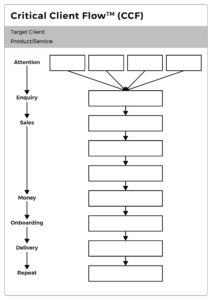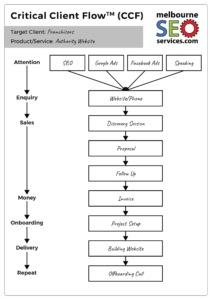If you’ve been in the business world long enough, you know of systems. Perhaps you’ve read The E-Myth, Traction or another book and are fired up about them. But HOW? Where should you start? You’re busy and so enmeshed in everything your business does that even thinking about which processes to systemise first is overwhelming.
Through my work helping hundreds of business owners free themselves from daily operations, I realised that systemising doesn’t have to be stressful or overwhelming. In fact, in just 20 minutes, any small business owner in any industry can identify the 10-15 systems that make the biggest impact. In this article, I’ll walk you through this — well, system — mapping out your Critical Client Flow (CCF) step-by-step.
The following is an excerpt from chapter one of my book, SYSTEMology. There, I share the method that has transformed hundreds of small businesses from owner-dependent, zero-systems businesses to finely tuned assets. Step-by-step, I show you how to create the systems you identify here (without you) and how to get your employees excited about systems, too. The Critical Client Flow (CCF) is the first step in the SYSTEMology method, a breakthrough system for creating systems.
All you need is a pen and paper. You can also go to systemology.com/resources to print out a plug-and-play CCF worksheet. We’ll fill it out together.
It looks like this:
How to Create Your Critical Client Flow (CCF)
In the CCF, you’ll map out the core of how your business works.
You’ll identify the minimum viable systems required to consistently bring in new business, convert those leads to clients and then deliver your product/service.
You’ll also see the ‘holes’ within your business, and it will help you develop laser-like focus on what needs to be systemised.
Before you start, read this carefully: the point of this exercise is to identify what is already happening in your business. Follow the following steps, recording your business as-is. Now is not the time to tweak things. You have to know where you are to know where you’re going!
Now you’re ready to begin!
Step #1: Identify ONE primary target client and ONE primary product you sell to that client.
At its core, profitable business is about solving problems; therefore, the first step is to be clear about the problem you’re solving and for whom you’re solving it.
Yes, it’s true, very few businesses have a single target client, let alone a single product or service. Some, particularly those selling physical products, may have hundreds or even thousands.
Regardless of how your business is structured, or the industry in which it operates, for this exercise, pick just ONE target client and ONE product or service.
(You can always go back and record more flows, but this isn’t the time to get too crazy. )
Which one do you pick? Start by thinking about your dream clients. The ones you enjoy working with the most. The ones who pay your advertised prices and then happily refer their friends and family.
Next, pick the product that would be the best starting point for that client. Ask yourself, what is a great first purchase for this client? Which one will open the door for you to continue working with them long-term?
And if you’re not yet clear on the problem your products and services solve and for whom, it’s best to figure that out first. Beginning to systemise is about cloning what’s already working within the business, so you need to be clear on where your sweet spot is located.
For example:
If you’re a bookkeeper, your target clients might be farmers, and your primary service is an initial financial audit.
If you’re a digital agency, maybe you serve franchisors, and your primary service is building them a new website.
Once you’re clear on your ONE central client and ONE primary product or service, fill in the blanks at the top of the worksheet.
Step #2: Define your Critical Client Flow.
There are key stages your clients and business go through to deliver your core product – from how you first get the attention of your target clients, through to delivering your product to them and hopefully turning them into repeat clients. The CCF identifies this as a series of linear events.
Note: The difference between a CCF and a typical ‘client journey’ is that it also focuses on the requirements of the business to deliver your product. If you already have your client journey mapped out, that’s great; no doubt it will help you complete the CCF. But they’re not the same.
Of course, every business is going to have a slightly different series of steps, but broadly speaking they’ll include most or all of the components below.
Before you begin, there are three rules to keep in mind:
- Don’t overthink this.
- Don’t go into detail – two or three words to label a step is all you need.
- Only populate the CCF with activities you are currently doing. Avoid filling in the blanks with things you’d like to be doing.
Let’s look at each component, starting from the top.
Attention: How do people learn about your business?
Search engine traffic? Pay-per-click ads? Podcast advertising? Direct mail? Speaking engagements? Referrals?
List your primary methods of getting your prospects’ attention.
Enquiry: When someone is ready to enquire about your products, how do they do it?
Is it through an inbound call, do they submit a web enquiry or both?
Sales: Your prospect has shown interest in your wares, and now they’re primed to become a client. What happens next?
Do they bring an item to the checkout counter? Do they add items to their online shopping cart and click on the ‘checkout’ button? Do they call you up to make an appointment? Do you issue proposals? How do you close the sale?
Just name the typical process, keeping in mind this exercise is for ONE core product being purchased by ONE specific target client. Don’t try to describe every possible sales process.
Money: How do you collect payment?
This could be an easy step – cash or card. Or, if you’re a service provider, you might invoice before the work is carried out. Or afterwards. Or a combination of the two.
Onboarding: How do you get your clients started?
You could probably list a whole bunch of systems here, but keep it simple. This could be putting the goods in a bag, or it could be an in-depth onboarding process involving questionnaires, setting up projects in a project management software and assigning the account manager.
With service-based businesses, how do you set up new clients before you create the deliverable?.
Don’t list more than one or two steps. You’ll build out the details later when you create the systems.
Delivery: How is the work completed?
A physical business might just involve handing the product over. But an e-commerce operation could cover ordering stock, checking it off, packaging it up and shipping it out.
For a service-based operation – a bookkeeper, for instance – this would include how to extract the initial data from the client’s accounting software, how it’s interpreted and how it’s delivered to the client.
Often, this step, in particular, gets people’s minds racing as they think about the multitude of steps in this process. Rest assured that you’ll capture all the details later as you flesh out these systems – for now, we keep it simple.
Repeat or referral: Last, but not least, how do you go about encouraging clients to either remain a client or come back again to make additional purchases?
If you’re in the business of selling coffins or some other product where you’re usually making a one-time sale, think in terms of referrals. How do you encourage your clients to send you new business?
The goal here is to break your business down into a linear series of steps that your clients move through when working with your business. It should consist of no more than 7–12 steps.
There’s a good chance you’ll experience some ‘a-ha’ moments as you go through this exercise because it often highlights areas of weakness and helps to explain why certain issues appear within your business. By capturing what you are actually doing, any holes become immediately apparen (Cash flow issues? You might be missing an invoicing process. And so on.)
These insights will guide you in optimising your systems later on, but for now, we’re just concentrating on how your business currently operates.
It’s not a problem if you have to massage the CCF a little to suit your situation. I know everyone’s business is a little different and there’s never a ‘one size fits all’.
However, If you end up with more than twelve steps, have another go at creating something shorter and more concise. You could, for instance, combine some of the steps, especially if they’re all carried out by the same person or department.
The goal, ultimately, is to explain in simple terms how your business works from start to finish, linearly.
Step #3: Share your completed CCF.
You can then test your result by sharing your creation with someone outside of the business – preferably someone who knows roughly what your business does but isn’t directly involved. If you can show them your CCF and they can understand it WITHOUT you having to talk them through the steps in great detail, you’re in good shape. If they find your creation confusing or too complex, have another go and simplify further.
Here are a couple of sample CCFs to give you some ideas.
Before you jump in and think, But my business is different, let me agree and say yes, it is. However, every business has a Critical Client Flow. I’ve never once, over the years of helping hundreds of people perform this exercise, found a business where I couldn’t identify their CCF.
Remember … one client, one product, one journey. Document that and you have a CCF. It doesn’t need to be perfect, and it doesn’t need to be all-inclusive. It just needs to exist.
Now you know which processes to systemise first.
The really exciting thing is, once you systemise this, you’re well on your way to solving your target clients’ problems without key person dependency. The CCF is also the first step to dramatically increasing your capacity and ability to create a scalable money machine.
We just struck right at the heart of the myth that you will need to create hundreds and hundreds of systems to build a systemised business. Instead, you will get tremendous wins by focusing on just the critical few.
Want to keep going with your systems? You just did the hardest part. You started the process of finally systemising your business. In the SYSTEMology book, you’ll get a fool-proof guide to create, implement, and continuously improve a fully systemised business. You can grab your copy here








